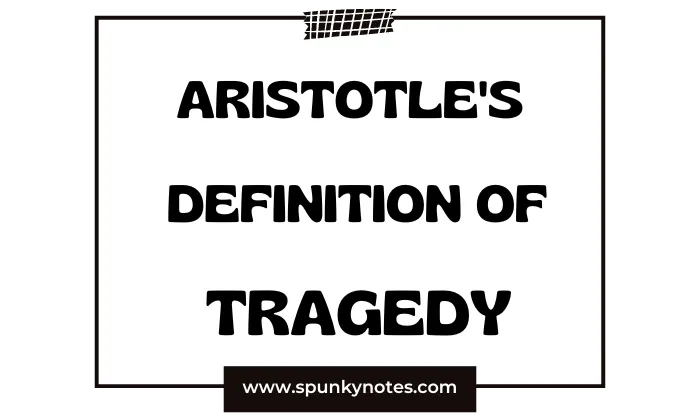

Estimated Reading Time: 9 min
Q. How does Aristotle’s Definition of Tragedy and its elements in “Poetics” provide a framework for understanding the essential components of a tragic drama?
Q. In Aristotle’s “Poetics,” what are the key components of tragedy as a dramatic genre, and how do these elements contribute to a tragic work’s overall impact and effectiveness?
Aristotle’s Definition of Tragedy
Aristotle defines tragedy in Book VI as “an imitation of an action that is serious, complete, and of a certain magnitude; in language embellished with each kind of artistic ornament, the several kinds being found in separate parts of the play; in the form of action, not of narrative; with incidents arousing pity and fear, wherewith to accomplish its catharsis of such emotions.”
Let’s break down each component of this definition:
Imitation of an action
It refers to the idea that tragedy represents or dramatizes serious and complete action rather than a direct presentation of actual events.
In other words, it is a fictional or imagined series of events portrayed on stage through characters’ actions and dialogue rather than recounting historical events or retelling true stories.
Aristotle’s concept of imitation is central to art. This imitation provides a deeper insight into human experiences.
In the case of tragedy, the imitation of action creates a more intense emotional experience for the audience as they become immersed in the dramatic events unfolding on stage.
In his explanation of imitation in tragedy, Aristotle compared it to music instead of painting. The composer creates a piece expressing emotions, themes, or ideas through rhythm, melody, and harmony.
Similarly, in tragedy, the playwright imitates serious and complete actions through the characters’ actions and dialogue, as well as the structure and language of the play.
Imitation isn’t a direct portrayal of reality. Unlike captured visuals in paintings, it conveys emotional and thematic elements. The focus of imitation is artistic expression.
The concept of creative imagination is essential to understanding the role of imitation in tragedy and music.
Both art forms rely on the artist’s ability to envision and create an original work that captures human emotions. However, the representation is not a direct, literal copy of reality. Creative imagination allows artists to go beyond mere imitation and infuse their work with unique insights, interpretations, and perspectives.
Serious
A tragedy should deal with important, consequential subject matter that explores deep human emotions and experiences. A tragedy often centres around human suffering, moral dilemmas, or the downfall of a central character.
These serious matters engage the audience emotionally and intellectually, leading them to reflect upon the human condition.
Complete
The plot of a tragedy should have a sense of completeness. It must have a well-defined beginning, middle, and end. A complete plot ensures that the story is coherent and unified.
It allows the audience to follow the events’ progression and understand the dramatic situations’ significance. A well-structured plot also contributes to the emotional impact of the tragedy.
Certain Magnitude
The events in a tragedy should be consequential and provoke deep emotions in the audience. Magnitude refers to the scope and significance of the events and characters portrayed.
In a tragedy, the characters are often of noble or high social standing, and the events are significant, often involving moral or ethical dilemmas or resulting in disastrous consequences. This magnitude creates a sense of gravity and urgency. It heightens the audience’s emotional engagement and ultimately contributes to the cathartic experience.
Language embellished with artistic ornament.
It refers to the use of language in a tragedy, precisely the idea that the language should be “embellished with each kind of artistic ornament.”
This means that the language in a tragedy should be heightened, poetic, and rich in literary devices, which enhance the dramatic effect and emotional impact of the play. Let’s examine the significance of this aspect:
Poetic Language
The tragedy is typically written in a poetic form, often using verse or meter, which gives the dialogue a rhythmic and musical quality. This heightened language elevates the play’s emotional intensity. It also creates a sense of beauty and artistry that engages the audience intellectually and emotionally.
Literary Devices
The language in a tragedy should be rich in metaphor, simile, imagery, and other rhetorical devices that add layers of meaning and depth to the dialogue. These devices make the language more vivid and evocative. It allows the playwright to convey complex ideas and emotions more effectively.
Character Differentiation
The use of embellished language can also help to differentiate characters, as each character’s speech may exhibit distinct styles, vocabularies, and patterns of speech that reflect their unique personalities, social status, or emotions.
Emotional Resonance
The artistic ornamentation of language in Aristotle’s definition of tragedy helps deepen the play’s emotional resonance. Using poetic language and rich imagery, the playwright can evoke powerful emotions in the audience. He can draw them into the story and make them more receptive to the explored themes and ideas.
In the form of action, not of narrative.
A tragedy emphasizes depicting events and emotions through the characters’ actions and dialogues rather than narration. This distinction has several implications for the structure and presentation of tragedy:
Show, don’t tell
In a tragedy, the playwright should strive to convey the story, emotions, and themes through the characters’ actions and interactions rather than relying on a narrator to describe or explain events.
By showing the events unfolding on stage, the audience can directly engage with the story and form their interpretations and emotional responses.
Character-Driven
When a tragedy is primarily concerned with action, the characters take centre stage, and their motivations, emotions, and relationships drive the plot.
Conflict and Tension
Focusing on action often highlights the conflicts and tensions between characters, as their actions reveal their desires, fears, and moral dilemmas.
These conflicts serve as the engine of the plot, propelling the story forward and creating dramatic tension that keeps the audience engaged and emotionally invested.
Incidents arousing pity and fear, wherewith to accomplish its catharsis of such emotions.
This highlights the emotional and psychological effects of tragedy on the audience and the essential role that these effects play in the overall experience of the play. Let’s examine the key elements of this point:
Pity and Fear
Aristotle identifies pity and fear as the two primary emotions tragedy should evoke in the audience.
Pity is the audience’s compassion and sympathy for the tragic hero’s suffering or downfall. Fear arises from the realization that such misfortune could happen to anyone.
Pity
According to Aristotle, pity arises from witnessing undeserved or disproportionate suffering that can relate to the audience, leading them to empathize with the characters.
There are a few key aspects of pity in Aristotle’s definition of tragedy:
Identification
The audience should be able to identify with the tragic hero or the characters in the play. They recognize elements of their lives, emotions, or experiences in the story. This identification allows the audience to feel a more profound sense of empathy and compassion for the characters’ suffering and misfortune.
Undeserved Suffering
The audience often feels pity when they perceive the tragic hero’s suffering or downfall as undeserved or disproportionate to his actions or mistakes. This sense of injustice or unfairness amplifies the audience’s sympathy and compassion for the character.
Vulnerability
Pity is heightened when the audience recognizes the tragic hero’s or other characters’ vulnerability and humanity. Watching the tragic hero battle forces beyond his control reminds the audience of their vulnerability. It also underscores the universality of human suffering.
Fear
In tragedy, fear is the apprehension or dread that arises from realizing that the tragic hero’s misfortune could happen to anyone.
Key aspects of fear in Aristotle’s definition of tragedy include
Universality
The audience feels fear when they realize the play’s tragic events could happen to them or others. These circumstances are not exclusive to the characters on stage.
This universality of suffering makes the audience more emotionally invested in the tragedy. They can relate to the characters and their predicaments on a personal level.
Unpredictability
The unpredictability and uncertainty of life can also contribute to the audience’s sense of fear. The tragic hero’s downfall or misfortune in a tragedy can result from unforeseen consequences or a sudden reversal of fortune.
Through witnessing such events, the audience is reminded of the unpredictable nature of life.
Consequences of Actions
When the audience considers the potential outcomes of their decisions or actions, it can also evoke fear. The tragic hero’s downfall often results from his flaws or mistakes. Seeing this, audiences reflect on their own choices. This leads them to consider the possible consequences of their actions.
Catharsis
Catharsis is a central concept in Aristotle’s theory of tragedy. However, it’s important to note that Aristotle does not provide an extensive or detailed explanation of catharsis in his Poetics.
Scholars have interpreted and debated its meaning ever since. Based on the context and Aristotle’s writings, catharsis can be understood as follows:
Emotional Purification
Often, the audience experiences catharsis as an emotional purification or purgation after watching a tragedy.”
Portraying the tragic hero’s suffering and downfall, the audience can confront and process their emotions, particularly pity and fear. By vicariously experiencing these emotions, the audience achieves relief and emotional release.
Intellectual Clarification
Some interpretations of catharsis emphasize the intellectual or cognitive aspect of the experience. In this view, catharsis involves clarifying or illuminating moral, ethical, or philosophical truths.
It allows the audience to gain insight into the human condition and the complexities of life.
Restoration of Emotional Balance
Another interpretation of catharsis suggests restoring emotional balance or equilibrium within the audience. The audience can release these feelings and achieve emotional balance. It can calm the audience through intense emotions such as pity and fear during the tragedy.
Sir Philip Sidney, in his “Defence of Poesy”, echoed some of the sentiments of Aristotle’s definition of tragedy. He viewed poetry, which includes drama, as an art form that can teach and delight. For Sidney, tragedy aims to depict virtuous individuals struggling against adversity, instructing the audience in virtue and morality.

